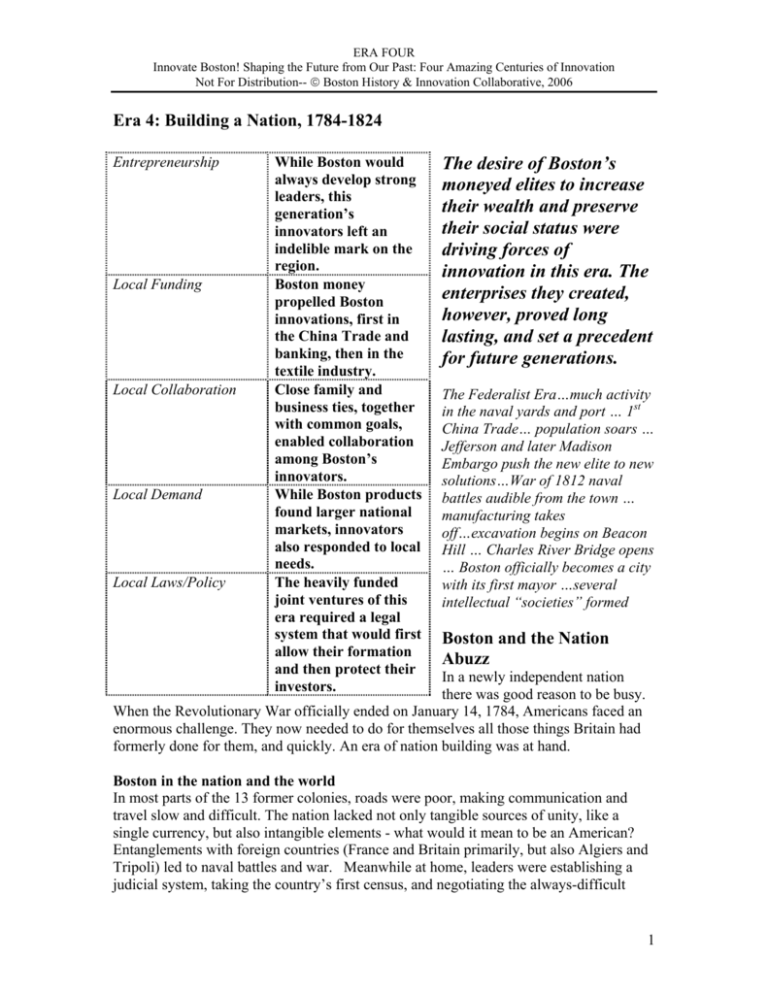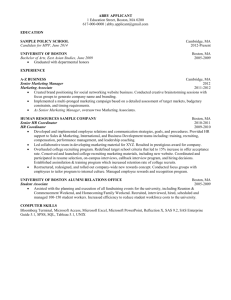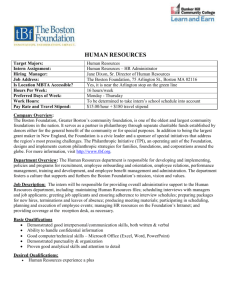
ERA FOUR
Innovate Boston! Shaping the Future from Our Past: Four Amazing Centuries of Innovation
Not For Distribution-- Boston History & Innovation Collaborative, 2006
Era 4: Building a Nation, 1784-1824
Entrepreneurship
Local Funding
Local Collaboration
Local Demand
Local Laws/Policy
While Boston would
always develop strong
leaders, this
generation’s
innovators left an
indelible mark on the
region.
Boston money
propelled Boston
innovations, first in
the China Trade and
banking, then in the
textile industry.
Close family and
business ties, together
with common goals,
enabled collaboration
among Boston’s
innovators.
While Boston products
found larger national
markets, innovators
also responded to local
needs.
The heavily funded
joint ventures of this
era required a legal
system that would first
allow their formation
and then protect their
investors.
The desire of Boston’s
moneyed elites to increase
their wealth and preserve
their social status were
driving forces of
innovation in this era. The
enterprises they created,
however, proved long
lasting, and set a precedent
for future generations.
The Federalist Era…much activity
in the naval yards and port … 1st
China Trade… population soars …
Jefferson and later Madison
Embargo push the new elite to new
solutions…War of 1812 naval
battles audible from the town …
manufacturing takes
off…excavation begins on Beacon
Hill … Charles River Bridge opens
… Boston officially becomes a city
with its first mayor …several
intellectual “societies” formed
Boston and the Nation
Abuzz
In a newly independent nation
there was good reason to be busy.
When the Revolutionary War officially ended on January 14, 1784, Americans faced an
enormous challenge. They now needed to do for themselves all those things Britain had
formerly done for them, and quickly. An era of nation building was at hand.
Boston in the nation and the world
In most parts of the 13 former colonies, roads were poor, making communication and
travel slow and difficult. The nation lacked not only tangible sources of unity, like a
single currency, but also intangible elements - what would it mean to be an American?
Entanglements with foreign countries (France and Britain primarily, but also Algiers and
Tripoli) led to naval battles and war. Meanwhile at home, leaders were establishing a
judicial system, taking the country’s first census, and negotiating the always-difficult
1
ERA FOUR
Innovate Boston! Shaping the Future from Our Past: Four Amazing Centuries of Innovation
Not For Distribution-- Boston History & Innovation Collaborative, 2006
issue of taxation. Boston merchants and leaders (Gov. Bowdoin) led the defense of the
new established order against the rural poor veterans in Shay’s Revolt. The revolt helped
the new revolutionary elite to turn to a model for a stronger central government.
Like the nation as a whole, Boston was a bustling place. The city which had emptied
during the war was now flooded with people. The U.S.S. Constitution was built in a
North End shipyard. Charles Bullfinch’s capitol building was constructed as the height of
Beacon Hill was leveled to gain ground for a new neighborhood. New meetinghouses
were established and the Boston Daily Advertiser began publishing. Boston’s merchants,
oriented as they were to commerce and industry, undertook their own projects to revive
the city’s financial well-being. Perhaps the ultimate entrepreneur was Frederick Tudor, an
imperious man, who developed markets for iced drinks in Cuba, New Orleans, Rio and
India, and developed a way of shipping frozen ice from Greater Boston ponds around the
world, profitably, very profitably, and even built one of the first railroads to connect
Fresh Pond to Tudor Wharf in Charlestown.
Era 4 Drivers
In establishing a new nation a group of leaders and entrepreneurs stepped up to guide the
town. Demand for products and challenges presented by the British navy gave rise to
new trade routes to China, South America, and the Mediterranean. In the town and state,
the chartering of public infrastructure to private owners and the rise of the Boston textile
industry marked a new epoch of government action and inaction. In order to perform
these feats, interest from within Boston’s community of leaders resulted in local networks
of collaboration as well as availability of local funding to support infrastructure projects
such as the Charles River Bridge, a technological breakthrough when it opened (1791).
The new government and Constitution was organic in its ability to change and mold to
the new conditions of the time. New government laws and policies gave greater
freedoms to private business and worked towards establishing a unique American
economy.
Innovation in this period is inextricably bound up with Bostonians’ intense drive towards
commercialization. Freed from colonial taxes and regulations but barred from lucrative
ports of call in the West Indies, Boston merchants demonstrated remarkable leadership
and a willingness to collaborate in rebuilding the city’s economic infrastructure. They
initiated new forms of commerce and industry, none of which could have succeeded as
solo ventures. Trade with China, the first State-chartered bank, the Waltham-Lowell
textile mills, the Suffolk System of bank note redemption, the Charles River Bridge…all
were too expensive and complicated to be undertaken alone. Their close family and
business ties were surely a factor, but Boston’s leading merchants also shared a desire to
increase their wealth and preserve their social status. To that end, they became adept at
seeking out the information they needed to initiate their ventures and in using the State’s
legal system to their benefit. Perhaps most significantly, Bostonians of this era set a
precedent for succeeding generations to follow. They managed to be simultaneously
inward-looking, in garnering their peers’ technical and financial support, yet also
2
ERA FOUR
Innovate Boston! Shaping the Future from Our Past: Four Amazing Centuries of Innovation
Not For Distribution-- Boston History & Innovation Collaborative, 2006
outward-looking in crafting their ventures to respond to larger national and international
demands.
Driving Boston Innovation in the New Nation
Any new nation needs to establish the mechanisms for commerce, trade and the
production of goods. A few specific factors allowed Bostonians to succeed in meeting
these challenges.
Entrepreneurship
This era’s innovations are marked by the presence of local leaders – both those we
remember and those we do not. They include men like Francis Cabot Lowell, Nathan
Appleton, and Patrick Tracy Jackson who founded and managed several textile
manufacturing companies, John Hancock and other investors in the Charles River
Bridge Company, and William Sturgis, Ben Forbes, and Thomas Handasyd Perkins,
both successful sailors and merchants who plied the trade with China. Lesser-known
men too demonstrated exceptional leadership, like the founders of the Massachusetts
Bank and the two directors of the Suffolk Bank who proposed what came to be called the
Suffolk System.
Local Funding
Bostonians in this period demonstrated a strong desire to reinvest and preserve their
capital in local enterprises. Bostonians preferred to form their own Massachusetts Bank
rather than place their money in the Bank of North America in Philadelphia. They used
the money they made in the China Trade to develop the Waltham-Lowell System,
which earned them even greater wealth, and funded the Charles River Bridge
Company. And their desire to safeguard their fortunes for future generations motivated
them to develop the legal mechanism of the Trust.
Local Collaboration
Boston’s wealthy elites demonstrated a capacity for collaboration that can be seen in each
of the innovations of this era. A small group of businessmen pooled their capital to start
the Massachusetts Bank, as did others in founding a textile-manufacturing corporation
with an innovative form of production (known later by its two cities of origin as the
Waltham-Lowell System). Familial and personal relations were the norm between many
of the merchants and seamen leading the China Trade. The Suffolk System succeeded
only because several banks were willing to work together to enforce common rules.
Bostonians established the nation’s first Trusts to prevent the disintegration of their large
fortunes over future generations, and to promote their ability to pool that wealth. In so
doing, they exhibited a high degree of unity, allowing them more success than richer
fellows in Philadelphia and New York.
Local Demand and Local Laws/Policies
The large number of merchants, counting houses, ports and craftsmen in Boston, together
with a shortage of hard currency and credit mechanisms after independence, resulted in a
pent-up demand for capital. In response, six Boston merchants founded the
3
ERA FOUR
Innovate Boston! Shaping the Future from Our Past: Four Amazing Centuries of Innovation
Not For Distribution-- Boston History & Innovation Collaborative, 2006
Massachusetts Bank to provide a means for currency exchange and for the pooling of
resources to fund business ventures. Building on an already busy local port with
extensive shipbuilding and seafaring knowledge, Bostonians were well-prepared to
capitalize on intense local and national desire for the goods of China. These and other
innovations of the era would not have been possible without the support and protection of
State laws. Charters granted to the Massachusetts Bank and the textile manufacturing
companies were important to help secure investors’ confidence, and thus the capital they
needed. So too with the first Trusts. Bostonians worked with influential jurists like
Joseph Story to secure the legal enforcement of their trusts, and to create the first
corporation charged with fiduciary powers over family fortunes. And, the Charles River
Bridge Company was the first company to successfully obtain its type of charter, an
award that marked a new era of cooperation between government and private business.
A Solid Foundation to Build On
Bostonians of the post-Revolutionary generation left to their predecessors’ great fortunes,
successful industries and a city with a sound financial infrastructure. But they also put in
place a tradition of collaboration, leadership, and civic-mindedness that would carry on
throughout Boston’s four centuries of innovation.
The Northwest China Trade: 1790 – 1840s
A lucrative trading route between Boston, the Pacific Northwest coast and Canton, China over which
Boston merchants maintained a near monopoly.
In 1790, the sailing ship Columbia arrived back in Boston after a three-year journey to Canton, China, by
way of the Pacific Northwest coast. There, Boston’s firearms, metals, textiles, foodstuffs and trinkets were
traded with Native Americans for sea otter skins, thus solving “the riddle of the China Trade” as Samuel
Eliot Morison put it, “to find something salable in Canton.”
Americans exhibited a strong demand for China’s tea, silks and porcelains, goods they had obtained as
colonists from British merchants. But while other nations arrived at Canton with silver, European coin and
opium, American traders had virtually nothing to offer the Chinese except ginseng, harvested in upstate
New York, and that in only small quantities. Even before the Columbia’s return, Boston merchants had
learned of her successful new trade route and begun making preparations to send their own ships to the
Northwest coast. Three left within a year – including the Columbia, which turned around almost
immediately upon her return for a second trip.
Although trade with China was conducted throughout the Eastern seaboard, the Northwest China Trade
was virtually exclusive to Boston. Strong local leaders propelled the trade. As William Sturgis, a
successful captain and merchant, explained, "It was attempted, unsuccessfully, from Philadelphia and New
York, and from Providence and Bristol…even the intelligent and enterprising merchants of Salem, failed of
success." So dominant, in fact, were Boston merchants and ships, that the Native Americans of the
Northwest coast called all Americans “Boston men” or “Bostonians.”
Boston’s success in the Northwest China Trade came as a result of a unique blend of both collaboration
and competition. Family ties created close bonds among merchants, captains and crew, while intense
competition between merchant houses fueled the speed with which they outfitted their ships. Underlying
both were the city’s intellectual and financial capital – extensive seafaring experience and the willingness
to devote local funding to the ventures.
4
ERA FOUR
Innovate Boston! Shaping the Future from Our Past: Four Amazing Centuries of Innovation
Not For Distribution-- Boston History & Innovation Collaborative, 2006
The Waltham-Lowell System: 1813 – 1830s
A system of textile production that differed from its predecessors in scale, process, labor supply, and
ownership.
When Francis Cabot Lowell and Nathan Appleton formed the Boston Manufacturing Company in 1813,
Boston was New England’s commercial center. Wealthy merchants, tradesmen, and laborers all coexisted
within a relatively fluid social structure. Flush with cash from their successful trading ventures, Lowell,
Appleton and several other leading merchants invested together in a textile mill in Waltham,
Massachusetts.
This mill was unique in several important respects. Where most textile mills in the U.S. were small affairs
with one or two owners, this mill was heavily capitalized with local funding from wealthy, interrelated
Boston families. Their collaboration was enabled not only by their familial relationships but also by local
laws, which allowed businesses to incorporate, thus providing their investors with an increased expectation
of the venture’s security and permanence.
The Waltham mill was innovative in other ways, too. It introduced a new system of textile production in
which two formerly separate processes of spinning yarn and weaving cloth were combined under the same
roof. And the laborers were almost entirely young women, in whose activities the mills owners and
managers took a paternalistic interest.
These Waltham innovations were quickly replicated in the mills of Lowell and Lawrence, where they’re
needs spawned further innovation in waterpower and textile technologies. The mills of the WalthamLowell system brought their investors enormous profits and brought about an economic boom in Boston
and New England. Appleton, now very wealthy, gave his son-in-law, Henry Wadsworth Longfellow, the
old Vassal mansion in Cambridge with his newfound wealth. The wealth created spilled over into related
industries and was used to fund many of Boston’s cultural institutions.
5
ERA FOUR
Innovate Boston! Shaping the Future from Our Past: Four Amazing Centuries of Innovation
Not For Distribution-- Boston History & Innovation Collaborative, 2006
Material from
Innovate Boston! Shaping the Future from Our Past:
Four Amazing Centuries of Innovation
2006
by Boston History & Innovation Collaborative
All rights reserved
The Boston History & Innovation Collaborative
650 Beacon St. Suite 403
Boston, MA 02215
617.350.0358
www.bostonhistorycollaborative.org
6








